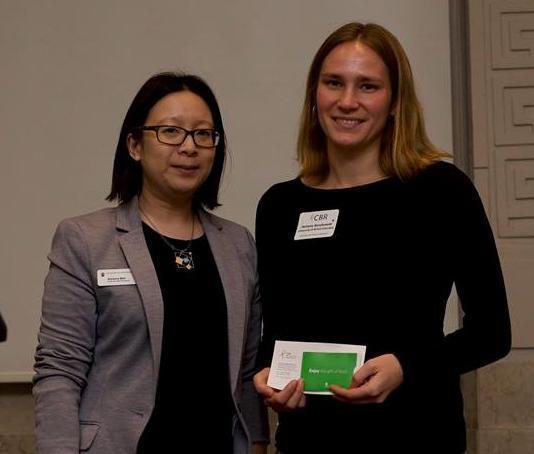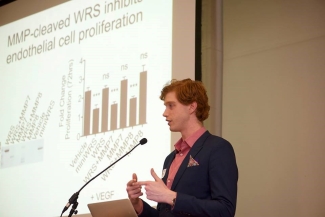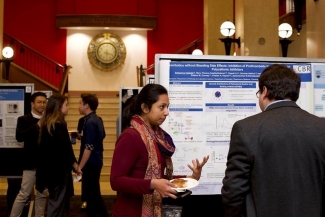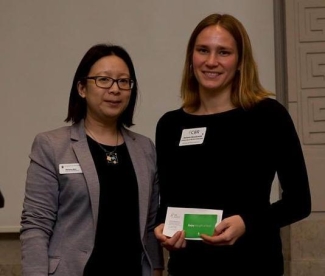12th Earl W. Davie Symposium: a focus on the next-generation of blood researchers

This post was contributed by Stefanie Novakowski, a PhD candidate in the Kastrup laboratory (Michael Smith Laboratories and the Centre for Blood Research, University of British Columbia). Tseday Tegegn and Bronwyn Lyons, also trainees at the Centre for Blood Research, contributed.
In November, the University of British Columbia Centre for Blood Research (CBR) hosted its 12th annual Earl W. Davie Symposium in Vancouver, BC. During the event, researchers, students, clinicians and patients discussed successes and ongoing challenges in hematology, from understanding basic mechanisms of clotting to improving patient care. Details of the invited talks can be found on the CBR’s blog here; however, a major part of what makes the day special is the enthusiastic participation of the CBR trainees. Throughout the day, the audience heard talks from four trainees, while 26 students presented their work during the poster sessions.
“Three of the invited speakers today told me how special the trainees are here at CBR. I have this on multiple occasions before! I think that CBR not only has an excellent recruitment process in place, but we also offer very good training programs.” - Dr. Ed Pryzdial, Canadian Blood Services scientist and associate director of the CBR
Trainee talks: from blood clotting to neuroinflammation

Parker Jobin (Overall Laboratory, University of British Columbia) presents his research during one of the day’s four trainee talks (Photo courtesy of the Centre for Blood Research.)
While the key proteins involved in blood clotting were identified by Dr. Earl W. Davie and his colleagues over 40 years ago, many questions remain, including questions about the role of coagulation factor XII (FXII) in regulating clotting. In the first trainee talk of the day, Tammy Truong (Weitz Laboratory, McMaster University), described her work characterizing the interaction between FXII and histidine-rich glycoprotein, a protein found in plasma and platelets. This work could aid in developing new treatments for blood clotting disorders, reducing the risk of bleeding associated with current drugs. Tammy was a recipient of the CBR’s newly-established travel awards, made possible through the Sheldon Naiman and Linda Vickars Hematology Endowment Fund.
Most people attending a symposium on blood research would not expect to hear about the impact of dietary fibre on their health; however, this was not the case at this year’s Symposium. In an engaging talk, Hannah Robinson, (Osborne Laboratory, University of British Columbia), described how high dietary levels of guar gum, a soluble fiber, provides protection in animal models of multiple sclerosis, preventing entry of immune cells into the nervous system. While guar gum can be found in ice cream, Hannah was quick to point out that “ice cream is not the cure for multiple sclerosis.”
Occasionally, new roles can be found for well-characterized proteins. In his talk, Parker Jobin, a MD/PhD student in Overall Laboratory (University of British Columbia), described how tryptophanyl-tRNA synthetase, a protein typically found within cells, can be released and alter cell growth in blood vessels, regulating inflammation. During the poster session, he shared how the Symposium has helped him in his professional development:
“At the Symposium, there’s a mix of both familiar and new faces. This provides an opportunity to hone your presentation skills in with colleagues you are comfortable with, while still meeting with many distinguished researchers and clinicians.” - Parker Jobin, Overall Laboratory
Poster presentations: the expanding realm of blood research

Sreeparna Vappala (Kizhakkedathu Laboratory, University of British Columbia) shares her work with an engaged attendee. (Photo courtesy of the Centre for Blood Research.)
At the Symposium, each of the poster presenters have the opportunity to practice their elevator pitches with 30-second ‘shotgun’ talks. Maria-Elizabeth Beava (Jefferies Laboratory, University of British Columbia) gave a particularly enthusiastic talk that highlighted how the field of blood research has grown since the early focus on blood clotting proteins, as her work focuses on possible links between eye disease and Alzheimer’s Disease. The Symposium offers both trainees and researchers a chance to learn about research outside of their area of study, an opportunity many trainees value.
“At the Symposium, you can meet patients, scientists and doctors. I had the opportunity to talk to a trauma surgeon today, which gave me a new perspective on my research. This Symposium is a great event that provides wonderful opportunities for students!” -Wayne Zhao, Devine Laboratory
Wayne is studying how temperature affects the quality and function of platelets used for transfusion, which are currently stored at room temperature. There is growing interest in storing platelets in the cold, as this may help improve their activity in patients with trauma and it may allow an extension of the shelf-life of platelets, which is currently limited to 7 days. Wayne’s findings may help inform Canadian Blood Services and other blood operators as they explore new possibilities with platelet products.
Platelets are also capable of mediating inflammation, and are known to bind to and internalize pathogens, including viruses. Tseday Tegegn (Pryzdial Laboratory) is following protein synthesis in platelets, with the goal of understanding how platelet interactions with the Dengue virus alter proteins in the cell. She is investigating whether this contributes to low platelet levels (thrombocytopenia) during infection. Moving from platelets to the immune system, Linda Yang (Scott Laboratory) is focused on adoptive cell immunotherapy, a promising potential treatment for cancer. She is studying what the cells used in this therapy release and deliver to cancer cells, to identify which specific components reduce cancer cell growth.
Throughout the day, posters were judged by the CBR’s post-doctoral fellows, research assistants, and investigators. This year’s winners were Emel Islamzada (3rd place), Tammy Truong (2nd place) and Stefanie Novakowski (1st place).

It’s all about the trainees: Dr. Stefanie Mak, Education Program Manager at the CBR, presents the 1st place poster award to Stefanie Novakowski (Photo courtesy of the Centre for Blood Research.)
Both Stefanie and Emel’s research demonstrate the roles of new technologies in blood research. Stefanie (Kastrup Laboratory, University of British Columbia) developed a method for delivering genetic material to platelets using nano-sized delivery systems, with the goal of creating modified platelets with improved activity during trauma or with extended shelf-life. Emel (Ma Laboratory, University of British Columbia) studies how red blood cells decrease in flexibility during storage using microfluidic devices, which allow single cells to be isolated and characterized. Her findings could potentially be used to identify ‘superdonors’, donors whose blood cells do not deteriorate during storage, leading to improved activity after transfusion.
From developing new drugs to learning how dietary fibre might impact our health, the 2018 EWD Symposium was a diverse and enlightening experience, and this based solely on the student presentations! The CBR symposia are always an invaluable learning experience for attendees, from trainees to patients to established researchers, and this year was no different.
The Centre for Blood Research at the University of British Columbia hosts three Canadian Blood Services scientists and affiliated staff, postdoctoral fellows and students. Canadian Blood Services and the Centre for Innovation are proud to partner with the Centre for Blood Research to deliver training and education events including the annual Earl W. Davie Symposium.
Canadian Blood Services – Driving world-class innovation
Through discovery, development and applied research, Canadian Blood Services drives world-class innovation in blood transfusion, cellular therapy and transplantation—bringing clarity and insight to an increasingly complex healthcare future. Our dedicated research team and extended network of partners engage in exploratory and applied research to create new knowledge, inform and enhance best practices, contribute to the development of new services and technologies, and build capacity through training and collaboration. Find out more about our research impact.
The opinions reflected in this post are those of the author and do not necessarily reflect the opinions of Canadian Blood Services nor do they reflect the views of Health Canada or any other funding agency.